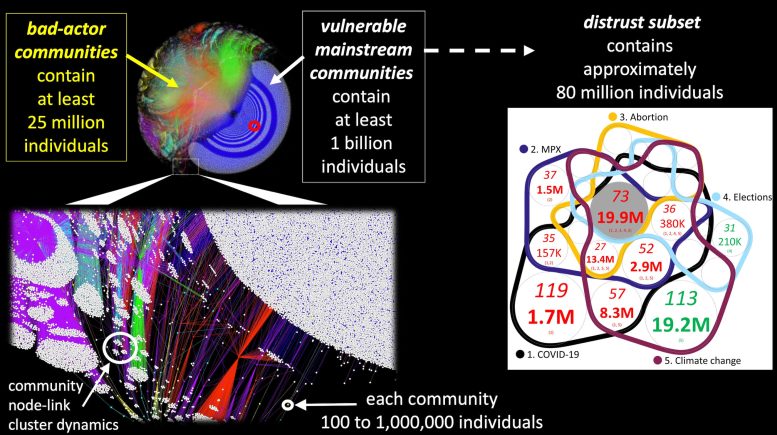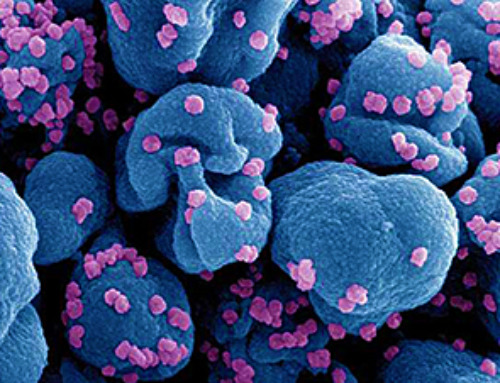A study forecasts that by mid-2024, bad actors are expected to increasingly utilize AI in their daily activities. The research, conducted by Neil F. Johnson and his team, involves an exploration of online communities associated with hatred. Their methodology includes searching for terminology listed in the Anti-Defamation League Hate Symbols Database, as well as identifying groups flagged by the Southern Poverty Law Center.
From an initial list of "bad-actor" communities found using these terms, the authors assess communities linked to by the bad-actor communities. The authors repeat this procedure to generate a network map of bad-actor communities—and the more mainstream online groups they link to.
Mainstream Communities Categorized as "Distrust Subset"
Some mainstream communities are categorized as belonging to a "distrust subset" if they host significant discussion of COVID-19, MPX, abortion, elections, or climate change. Using the resulting map of the current online bad-actor "battlefield," which includes more than 1 billion individuals, the authors project how AI may be used by these bad actors.
The bad-actor–vulnerable-mainstream ecosystem (left panel). It comprises interlinked bad-actor communities (colored nodes) and vulnerable mainstream communities (white nodes, which are communities to which bad-actor communities have formed a direct link). This empirical network is shown using the ForceAtlas2 layout algorithm, which is spontaneous, hence sets of communities (nodes) appear closer together when they share more links. Different colors correspond to different platforms. Small red ring shows 2023 Texas shooter's YouTube community as illustration. Right panel shows Venn diagram of the topics discussed within the distrust subset. Each circle denotes a category of communities that discuss a specific set of topics, listed at bottom. The medium size number is the number of communities discussing that specific set of topics, and the largest number is the corresponding number of individuals, e.g. gray circle shows that 19.9M individuals (73 communities) discuss all 5 topics. Number is red if a majority are anti-vaccination; green if majority is neutral on vaccines. Only regions with > 3% of total communities are labeled. Anti-vaccination dominates. Overall, this figure shows how bad-actor-AI could quickly achieve global reach and could also grow rapidly by drawing in communities with existing distrust. Credit: Johnson et al.
The authors predict that bad actors will increasingly use AI to continuously push toxic content onto mainstream communities using early iterations of AI tools, as these programs have fewer filters designed to prevent their usage by bad actors and are freely available programs small enough to fit on a laptop.
AI-Powered Attacks Almost Daily by Mid-2024
The authors predict that such bad-actor-AI attacks will occur almost daily by mid-2024—in time to affect U.S. and other global elections. The authors emphasize that as AI is still new, their predictions are necessarily speculative, but hope that their work will nevertheless serve as a starting point for policy discussions about managing the threats of bad-actor-AI.
Reference: "Controlling bad-actor-artificial intelligence activity at scale across online battlefields" by Neil F Johnson, Richard Sear and Lucia Illari, 23 January 2024, PNAS Nexus.
DOI: 10.1093/pnasnexus/pgae004
News
Platelet-inspired nanoparticles could improve treatment of inflammatory diseases
Scientists have developed platelet-inspired nanoparticles that deliver anti-inflammatory drugs directly to brain-computer interface implants, doubling their effectiveness. Scientists have found a way to improve the performance of brain-computer interface (BCI) electrodes by delivering anti-inflammatory drugs directly [...]
After 150 years, a new chapter in cancer therapy is finally beginning
For decades, researchers have been looking for ways to destroy cancer cells in a targeted manner without further weakening the body. But for many patients whose immune system is severely impaired by chemotherapy or radiation, [...]
Older chemical libraries show promise for fighting resistant strains of COVID-19 virus
SARS‑CoV‑2, the virus that causes COVID-19, continues to mutate, with some newer strains becoming less responsive to current antiviral treatments like Paxlovid. Now, University of California San Diego scientists and an international team of [...]
Lower doses of immunotherapy for skin cancer give better results, study suggests
According to a new study, lower doses of approved immunotherapy for malignant melanoma can give better results against tumors, while reducing side effects. This is reported by researchers at Karolinska Institutet in the Journal of the National [...]
Researchers highlight five pathways through which microplastics can harm the brain
Microplastics could be fueling neurodegenerative diseases like Alzheimer's and Parkinson's, with a new study highlighting five ways microplastics can trigger inflammation and damage in the brain. More than 57 million people live with dementia, [...]
Tiny Metal Nanodots Obliterate Cancer Cells While Largely Sparing Healthy Tissue
Scientists have developed tiny metal-oxide particles that push cancer cells past their stress limits while sparing healthy tissue. An international team led by RMIT University has developed tiny particles called nanodots, crafted from a metallic compound, [...]
Gold Nanoclusters Could Supercharge Quantum Computers
Researchers found that gold “super atoms” can behave like the atoms in top-tier quantum systems—only far easier to scale. These tiny clusters can be customized at the molecular level, offering a powerful, tunable foundation [...]
A single shot of HPV vaccine may be enough to fight cervical cancer, study finds
WASHINGTON -- A single HPV vaccination appears just as effective as two doses at preventing the viral infection that causes cervical cancer, researchers reported Wednesday. HPV, or human papillomavirus, is very common and spread [...]
New technique overcomes technological barrier in 3D brain imaging
Scientists at the Swiss Light Source SLS have succeeded in mapping a piece of brain tissue in 3D at unprecedented resolution using X-rays, non-destructively. The breakthrough overcomes a long-standing technological barrier that had limited [...]
Scientists Uncover Hidden Blood Pattern in Long COVID
Researchers found persistent microclot and NET structures in Long COVID blood that may explain long-lasting symptoms. Researchers examining Long COVID have identified a structural connection between circulating microclots and neutrophil extracellular traps (NETs). The [...]
This Cellular Trick Helps Cancer Spread, but Could Also Stop It
Groups of normal cbiells can sense far into their surroundings, helping explain cancer cell migration. Understanding this ability could lead to new ways to limit tumor spread. The tale of the princess and the [...]
New mRNA therapy targets drug-resistant pneumonia
Bacteria that multiply on surfaces are a major headache in health care when they gain a foothold on, for example, implants or in catheters. Researchers at Chalmers University of Technology in Sweden have found [...]
Current Heart Health Guidelines Are Failing To Catch a Deadly Genetic Killer
New research reveals that standard screening misses most people with a common inherited cholesterol disorder. A Mayo Clinic study reports that current genetic screening guidelines overlook most people who have familial hypercholesterolemia, an inherited disorder that [...]
Scientists Identify the Evolutionary “Purpose” of Consciousness
Summary: Researchers at Ruhr University Bochum explore why consciousness evolved and why different species developed it in distinct ways. By comparing humans with birds, they show that complex awareness may arise through different neural architectures yet [...]
Novel mRNA therapy curbs antibiotic-resistant infections in preclinical lung models
Researchers at the Icahn School of Medicine at Mount Sinai and collaborators have reported early success with a novel mRNA-based therapy designed to combat antibiotic-resistant bacteria. The findings, published in Nature Biotechnology, show that in [...]
New skin-permeable polymer delivers insulin without needles
A breakthrough zwitterionic polymer slips through the skin’s toughest barriers, carrying insulin deep into tissue and normalizing blood sugar, offering patients a painless alternative to daily injections. A recent study published in the journal Nature examines [...]






















